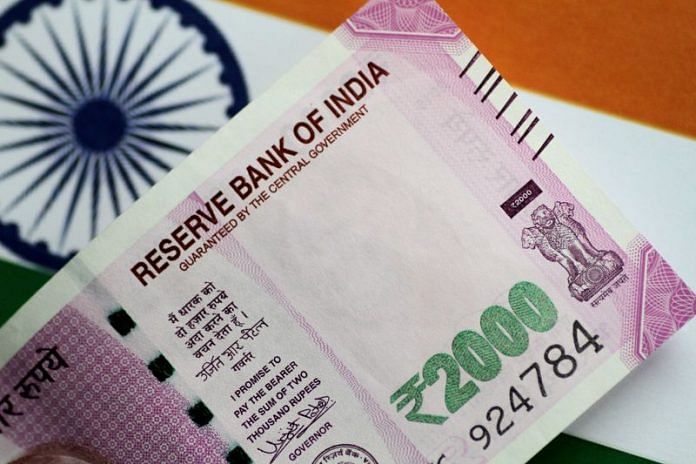
Thank you dear subscribers, we are overwhelmed with your response.
Your Turn is a unique section from ThePrint featuring points of view from its subscribers. If you are a subscriber, have a point of view, please send it to us. If not, do subscribe here: https://theprint.in/subscribe/
“RBI kehta hai – Jankar baniye” – the beaming face of Mr. Amitabh Bachchan flashes on the TV screen and it speaks of the benefits of several schemes of RBI and pleads for the awareness of the common man on these issues.
But these concerns seem to be off RBI’s mind while issuing a press-note and ringing an alarm bell on withdrawal of ₹2000 banknote from circulation and finally demonetizing it wef 1st. October 2023. RBI is too happy to announce it with a ‘sunset clause’, of which it is so fond of, by 30th.Sept 2023; by allowing people more than 4 months’ time. The RBI has further made clear in the press-note that this has been done as a measure of ‘Clean Note Policy’ of RBI.
But, the alibi of ‘Clean Note Policy’ and the timing of withdrawal of the said banknote from circulation and resultant demonetization smell other than pure banking and money circulation issues. But let me first analyse what RBI intended us to believe as per the choice of words for its press release.
It leads first to the issue of monetization of a uniquely denominated ₹2000 banknote and its announced death by demonetization on 30th.Sept 2023. The press release says the banknote was “introduced ……… primarily to meet the currency requirement of the economy in an expeditious manner after the withdrawal of legal tender status of all ₹500 and ₹1000 banknotes in circulation at that time.” We all by now know why those notes were demonetized and the resultant ordeal to RBI, Banks and the people in general. The efficacy of the demonetization has not been justified yet with conclusive proofs, as on date. It was more of a Tughlaq’s decision. Didn’t the sagacious minds of people at the helm of RBI’s affairs speak out then that substituting with a higher-denominated note would not serve the purpose in an economy mostly used to ₹100 banknotes. In note circulation, the basic tenet is, it should be convenient to the people. As adviser to GoI on money matters, why did the RBI falter then? RBI had obviously succumbed.
This time also the RBI has succumbed. RBI speaks of the ‘Clean Note Policy’ to justify this practical demonetization in the garb of time-bound withdrawal from circulation. For all practical purposes, it is demonetization as people can’t use it as a legal tender except with a bank for the limited period upto 30 Sept 2023. To whom is RBI fooling? By now, it has educated the common man enough on currency matters and the economy. Log jankar ho gayen hein.
The press release speaks, “The objective of introducing ₹2000 banknotes was met once banknotes in other denominations became available in adequate quantities. Therefore, printing of ₹2000 banknotes was stopped in 2018-19.” To justify the withdrawal the release further says, “It has also been observed that this denomination is not commonly used for transactions.” and that its share (percentage) in total notes in circulation has come down from a peak 37.3% in March 2018 to 10.8% in March 2023. If RBI didn’t print these notes since 2018-19 and that the purpose of its expedient monetization was over by issuance of small currency notes and that its use by the common man as a legal tender was getting very negligible, why didn’t it do this withdrawal process much earlier than now as some other extraneous considerations have presumably come into play? Doesn’t RBI know that the banknotes in circulation by the general public depends of the volume of transaction done on price of things/services and the amount of average bill, which is ₹100 or a few multiples thereof. In a scenario like this, how could the RBI expect ordinary transactions in ₹2000 banknotes otherwise than a situation of inflation touching such a high that ordinary things are priced, as is the case in one neighbouring country. A pertinent question to RBI in this context would be on the reasons of vanishing of ₹200 banknotes from circulation. A recent survey says that by the volume and value of transactions,₹250-denominated currency is best suited to India.
Now a few points on ‘Clean Note Policy’. Had the RBI been more than transparent on this issue, it could have released along with this release, its accepted ‘Clean Note Policy”; after all, it is a policy. As far as I understand from the policy, the mechanism is to ensure that soiled, defaced and disfigured notes are taken out of circulation and accordingly replaced by fresh notes. The underlying principle of clean note policy is to maintain unhindered circulation of currencies for smooth functioning of the economy and it never has been thought of as measure of demonetization.
Mr Tughlaq did mistake one, this time he has found more than an agreeing shoulder!
These pieces are being published as they have been received – they have not been edited/fact-checked by ThePrint.

COMMENTS